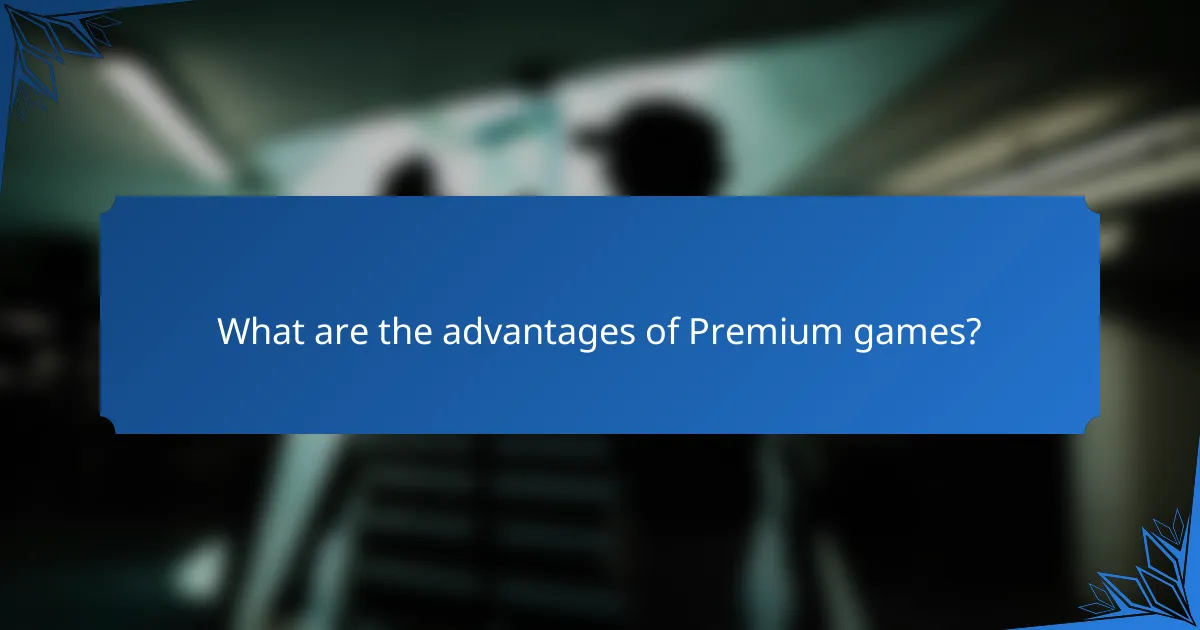The debate between Free-to-Play (F2P) and Premium games centers on player accessibility and overall experience. F2P games attract larger audiences by eliminating upfront costs, fostering community engagement, while Premium games offer a polished experience free from in-game purchases. Understanding when to use each model is crucial for maximizing player retention and satisfaction.

What are the advantages of Free-to-Play games?
Free-to-Play (F2P) games offer several advantages, primarily attracting a larger player base without upfront costs. They allow players to experience the game without financial commitment, which can lead to increased engagement and community growth.
Wider audience reach
Free-to-Play games can reach a broader audience compared to premium titles because they eliminate the initial purchase barrier. Players who may be hesitant to spend money on a game are more likely to try a F2P option, leading to a diverse player demographic.
This wider reach can be particularly beneficial for developers, as a larger player base can result in increased visibility and potential revenue through in-game purchases and advertising. Many successful F2P games have millions of active users, showcasing the potential for extensive engagement.
Lower entry barrier
The lower entry barrier of Free-to-Play games encourages players to join without the risk of losing money on a game they may not enjoy. This accessibility fosters a more inclusive gaming environment, allowing players from various backgrounds to participate.
Additionally, the lack of upfront costs means that players can explore different genres and styles without financial pressure. This can lead to a more vibrant gaming community where players share experiences and recommendations, further enhancing the game’s popularity.
Potential for microtransactions
Free-to-Play games often incorporate microtransactions, allowing players to purchase in-game items or enhancements. This model can generate significant revenue for developers, as players who enjoy the game may be willing to spend on cosmetic items, upgrades, or additional content.
However, it’s essential for developers to balance monetization with player satisfaction. Excessive or intrusive microtransactions can lead to player frustration and backlash. Successful F2P games typically offer valuable content without making it mandatory to spend money, ensuring a positive experience for all players.

What are the advantages of Premium games?
Premium games offer several advantages, primarily centered around a one-time purchase model that enhances the overall gaming experience. Players typically enjoy a more polished product without the interruptions of in-game purchases, leading to a more immersive experience.
Higher initial revenue
Premium games generate higher initial revenue compared to free-to-play titles due to their upfront cost. Players pay a set price, often ranging from $10 to $60, which can lead to significant earnings for developers right from launch. This model allows studios to invest more in quality and content from the outset.
Additionally, the higher price point can create a perception of value, attracting players who are willing to pay for a more complete gaming experience. This initial revenue can also support ongoing development and updates, ensuring the game remains engaging over time.
Enhanced player experience
Premium games often provide an enhanced player experience by delivering high-quality graphics, storytelling, and gameplay mechanics. Without the need for constant monetization through in-game purchases, developers can focus on creating a cohesive and immersive world. This leads to a more satisfying experience for players who prefer uninterrupted gameplay.
Moreover, premium titles frequently include all content upfront, allowing players to explore the game fully without the frustration of paywalls. This approach fosters a stronger connection between players and the game, as they can invest time and effort without worrying about additional costs.
No in-game purchases
One of the key advantages of premium games is the absence of in-game purchases, which can detract from the gaming experience. Players can enjoy the entire game without being prompted to spend more money on items or upgrades. This model appeals to those who dislike the pressure to make additional purchases to progress.
Furthermore, the lack of in-game purchases can lead to a more balanced gameplay experience, as all players start on equal footing. This fairness can enhance competition and community engagement, as players are less likely to feel disadvantaged by those who spend more money on enhancements.

When should you choose Free-to-Play over Premium?
Choosing Free-to-Play (F2P) over Premium is ideal when your goal is to attract a wider audience without upfront costs. F2P models allow players to engage with your game at no initial expense, which can lead to higher player retention and monetization through in-game purchases.
Targeting casual gamers
Free-to-Play games are particularly effective for targeting casual gamers who may be hesitant to spend money upfront. These players often prefer to try a game without financial commitment, making F2P an attractive option. By offering a free entry point, you can capture the interest of a broader demographic.
Casual gamers typically engage in shorter play sessions and may not invest heavily in a game. Therefore, designing your F2P game with quick, enjoyable experiences can enhance player satisfaction and encourage them to spend on optional in-game content.
Building a large player base
Free-to-Play models are advantageous for rapidly building a large player base. Since there are no barriers to entry, more players are likely to download and try your game. This can create a vibrant community, which is essential for multiplayer games or those relying on social interactions.
To maximize player acquisition, consider implementing referral bonuses or limited-time events that encourage players to invite friends. These strategies can significantly boost your player numbers and enhance the overall gaming experience.
Testing new game concepts
Using a Free-to-Play model allows developers to test new game concepts with minimal risk. By releasing a game for free, you can gather valuable feedback from players without the pressure of immediate sales. This approach can help refine gameplay mechanics and identify what resonates with your audience.
When testing, focus on collecting data on player engagement and spending habits. This information can guide future updates or entirely new projects, ensuring that you align your offerings with player preferences and market trends.

When should you choose Premium over Free-to-Play?
Choosing Premium over Free-to-Play is ideal when you want to provide a complete gaming experience without the limitations often found in free models. Premium games typically offer richer content, fewer interruptions, and a more engaging user experience, making them appealing to serious gamers.
Offering a complete experience
Premium games usually deliver a full, uninterrupted experience, allowing players to enjoy all features without the need for in-game purchases. This model often includes extensive storylines, high-quality graphics, and comprehensive gameplay mechanics that free-to-play versions might lack.
For example, a premium game might offer all levels and characters upfront, while a free-to-play version may restrict access to certain features unless players pay. This completeness can enhance player satisfaction and retention.
Attracting dedicated gamers
Premium games tend to attract a more dedicated player base willing to invest time and money into their gaming experience. These players often appreciate the value of a one-time purchase that grants full access to the game.
By focusing on quality and depth, premium offerings can foster a loyal community, as players are more likely to engage with a game that respects their investment. This can lead to better word-of-mouth promotion and sustained interest over time.
Maximizing revenue potential
While free-to-play games can generate revenue through microtransactions, premium games often provide a more stable income stream through upfront purchases. This model can lead to higher initial sales, especially if the game is well-marketed and receives positive reviews.
Additionally, premium games can capitalize on expansions or downloadable content (DLC) after launch, creating further revenue opportunities. Developers should consider their target audience and market trends to optimize pricing strategies and maximize profitability.

What are the key factors to consider in your decision?
When deciding between free-to-play and premium models, consider factors like your target audience, game genre, and monetization strategies. Each model has unique advantages and challenges that can significantly impact player engagement and revenue potential.
Target audience demographics
Understanding your target audience is crucial in choosing between free-to-play and premium models. Free-to-play games often attract a broader demographic, including casual gamers who may be hesitant to spend money upfront. In contrast, premium games typically appeal to dedicated gamers willing to invest in quality experiences.
Consider conducting market research to identify the preferences and spending habits of your audience. For example, younger players may prefer free-to-play options, while older gamers might lean towards premium titles.
Game genre and design
The genre and design of your game can heavily influence the choice between free-to-play and premium. Certain genres, like mobile puzzle games or battle royale shooters, thrive on free-to-play models due to their potential for high player retention and in-game purchases. Conversely, narrative-driven games or complex RPGs often benefit from a premium model, as players are more likely to pay for a complete experience.
Evaluate how your game’s mechanics align with each model. If your game encourages ongoing engagement through updates and expansions, a free-to-play model might be more suitable.
Monetization strategies
Your monetization strategy is a key factor in deciding between free-to-play and premium. Free-to-play games typically rely on in-game purchases, advertisements, or subscription models to generate revenue. This approach can lead to higher player acquisition but may require careful balancing to avoid alienating users with aggressive monetization tactics.
On the other hand, premium games generate revenue through upfront purchases. This model can lead to a more committed player base but may limit your audience size. Consider your long-term goals and how each strategy aligns with your vision for the game.

How do player retention rates differ between models?
Player retention rates can vary significantly between free-to-play (F2P) and premium models. Generally, F2P games may attract a larger player base but often struggle with long-term engagement, while premium games tend to foster deeper connections with a smaller audience.
Free-to-Play retention challenges
Free-to-play games face unique retention challenges primarily due to their monetization strategies. Many players may download these games without a strong commitment, leading to high initial drop-off rates. The reliance on in-game purchases can also create a divide, where paying players enjoy enhanced experiences while non-paying users may feel neglected.
Another challenge is the presence of ads, which can disrupt gameplay and frustrate users. This can lead to negative experiences that drive players away. To combat this, developers should focus on creating engaging content that encourages players to return, such as regular updates and community events.
To improve retention, F2P games should implement effective onboarding processes that educate players about game mechanics and benefits. Additionally, offering incentives for daily logins or completing challenges can help maintain player interest over time.



